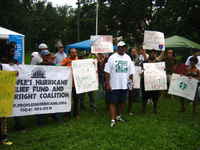The violation of the Right to Return of the Survivors
Why the Zero Evictions Campaign in New Orleans
Government actions at the local, state and federal level, however, have all appeared designed to prevent poor communities from coming home.
One of the gravest threats to human rights has been government actions violating the human right to housing in New Orleans. As we speak, developers – pursuant to federal legislation – are demolishing public housing units across New Orleans – the only housing affordable to thousands of families living in the city.
Who benefits from the demolition of undamaged or minimally damaged public housing?
In the aftermath of Hurricanes Katrina and Rita, as public housing residents attempted to return to their homes, most of which sustained little storm damage , they were met with police harassment, armed guards, and, in some instances, newly erected barbed wire fences.
Rather than release thousands of undamaged and minimally damaged housing units to displaced residents, HUD officials, the national agency charged with oversight over public housing across the nation, boarded up homes and purposefully failed to repair the units or take steps to mitigate further mold contamination. In June 2006, national housing agency (HUD) released plans to demolish 4,800 units of public housing, many of which were not damaged by the storms.
The demolitions will adversely affect more than 20,000 people and are part of a larger policy initiative directed by HUD under the auspices of the national Hope VI Program and other urban renewal projects which has already drastically reduced the number of public and affordable housing across the country.
To date, 86% of the pre Katrina and Rita public housing stock in New Orleans has remained boarded up and closed. This has occurred despite astronomical increases in housing prices across the city.
On December 20, 2007 , the City Council approved the demolition of the four major public housing developments in New Orleans: B.W. Copper, C.J. Peete, Lafitte and St. Bernard. Approximately 500 tenants and their supporters were locked out of the meeting. These residents, advocates, and members of the media were peppered sprayed, and some tasered. About a dozen people were arrested, including long-standing housing rights activists, for demanding that the City Council let people in to the empty seats to attend the meeting.
In approving the demolitions, the City Council urged the national housing agency (HUD) to develop one for one replacement of affordable housing in New Orleans. Yet, as of March 7, 2008 , the mayor of New Orleans, Ray Nagin, still had not received these assurances from national housing agency (HUD). Additionally, there have been widespread reports of corruption and self dealing by the national housing agency (HUD) whose Secretary, Alphonso Jackson, recently appeared before the Senate Banking Committee to address allegations of corruption. On March 31, 2008 Secretary Jackson resigned due to these allegations.
The demolitions and mixed income redevelopment sends a clear message that regardless of political promises the vast majority of pre Katrina and Rita, low-income, and predominantly African American, public housing residents will not be welcomed back. Around the country mixed income redevelopment, based on privatization models, has typically reduced the number of units affordable to low-income families, often by as much as 80 to 90% .
Solidarity with the struggle to stop the demolitions
Despite local and national outrage, demolitions of St. Bernard and B.W. Copper began in January.
On February 28, 2008 the UN Special Rapporteur on Adequate Housing, Miloon Kothari, and the UN Independent Expert on minority issues, Gay McDougall, issued a joint press statement expressing serious concern over the process leading to the demolitions and calling for a halt to the ongoing demolitions. The statement expressed the UN Independent Experts’ dismay over reports of violations of international human rights law in connection with these demolitions, including the right to participation and the right to adequate housing , for former public housing residents.
While there are no precise figures on the racial breakdown of the poor and working people still displaced, indications strongly suggest they are overwhelmingly African American. The African American population of New Orleans has plummeted by 57 percent, while the White population fell 36 percent, according to census data. The areas which are fully recovering are more affluent and predominately White. New Orleans, which was 67 percent African American population before Katrina, is estimated to be no higher than 58 percent African American now.
The crisis of homelessness in New Orleans continues with hundreds of people sleeping under the highway over Claiborne Avenue. The population of homeless in New Orleans is estimated at 12,000 people – double what is was before Katrina.
There have been a number of demonstrations in New Orleans and around the country to fight against demolition and homelessness. International solidarity will greatly assist in bringing international attention to the grave violations Katrina and Rita Survivors continue to face.
Videos on the Crisis in New Orleans :
- "Survivors Village July 4th" - http://video.google.com/videoplay?docid=-4985761531191981165&hl=en
- "Taking Back New Orleans One Step at a Time - http://video.google.com/videoplay?docid=-1359940050917523681
- "When the Saints Come Marching In" - http://www.bravenewfoundation.org/
- H.O.P.E. Video - http://www.survivorsvillage.com/HOPEvideo.html
- New Orleans City Council Bars Public From Housing Vote - http://www.youtube.com/watch?v=btC4Uz1YL1A



